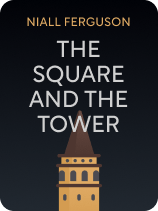

This article is an excerpt from the Shortform book guide to "The Square and the Tower" by Niall Ferguson. Shortform has the world's best summaries and analyses of books you should be reading.
Like this article? Sign up for a free trial here.
What, exactly, is a hierarchy? What does a hierarchical network look like in society?
Historian Niall Ferguson applies network theory to his analysis of world history. In doing so, he makes three key observations: Hierarchies are necessary to maintain social order, additional networks tend to undermine hierarchies, and hierarchies can deal with only a limited amount of complexity.
Continue reading to see how Ferguson applies the hierarchical network model to society.
Hierarchical Network Model
According to Ferguson, a hierarchy is a specific kind of network in which one entity exercises authority over others who in turn exercise authority over others, and so on, without any other connections of authority or loyalty. This means that the first entity automatically has the most betweenness, because all information flows up from every lower entity, passes through the person at the top, and only then is distributed elsewhere. The importance of individual entities diminishes as you go down the tiers of the hierarchy because each entity is connected only to its own subordinates and its lone superior.
(Shortform note: In principle, a hierarchy doesn’t have to be about interpersonal power. Ferguson focuses mostly on government hierarchies and similar power structures, where most of the connections between individuals involve bonds of loyalty or authority. But, computer scientists have found that hierarchical networks are a very efficient way to connect computers and peripheral devices. A hierarchical network of computers illustrates how the same network structure can distribute data rather than authority.)
Three Principles of Hierarchies
As Ferguson looks at world history, he sees the hierarchical network model at work. He identifies three truths about hierarchies that are evident in society. Let’s take a look at each one.
#1: Hierarchies Maintain Order
Ferguson observes that many important networks, such as governments and corporations, are at least approximately hierarchical in their structure. He suggests that these networks tend to take the form of hierarchies because hierarchies are particularly efficient when it comes to coordinating activities and resolving disputes. He explains that hierarchies facilitate dispute resolution because any two entities that disagree can appeal to their shared superior. But, if they don’t have anyone that they both regard as superior, then their differences continue to fester—sometimes until they go to war and the victor emerges as the superior in a new hierarchy.
For this reason, Ferguson goes so far as to say that peace and social order are possible only when there is a clear hierarchy that everyone accepts as legitimate. In most cases, a government is the hierarchy that maintains order. But sometimes, alternative entities establish the hierarchy. For example, international treaties often have the effect of creating a hierarchy of national powers: The treaty itself acts as a moderator between nations by establishing agreements and relationships between them, as well as provisions for enforcement, yet without creating an international government, per se.
| What Does It Take to Keep the Peace? Some people disagree with Ferguson’s assertion that hierarchies are the only way to keep the peace. For example, in The Anatomy of Peace, the Arbinger Institute argues that conflict is something we create unnecessarily by adopting a combative mindset. The Institute says that if you treat other people as obstacles to your own success, they tend to react defensively. This makes it difficult to resolve your disagreements without a court or other power structure to arbitrate between you and enforce its rulings. But, if you rethink your situation, set aside your own biases, and look for ways to help others instead of seeing them as obstacles, you can build cooperative relationships with them. Your relationship then makes disagreements easy to resolve whenever they do arise, without having to appeal to a higher authority. If everyone took this approach, then the resulting network of cooperative relationships would provide an alternative means of keeping the peace to the hierarchy that Ferguson says is necessary. |
#2: Additional Networks Undermine Hierarchies
Ferguson’s second conclusion is that any other network that creates additional connections of loyalty between entities within a hierarchy weakens the power of the hierarchy. This is because the additional connections reduce the betweenness of the entities in the tiers above them so that the higher-up entities no longer are the sole pass-through points for information. Any network that allows people to share ideas outside of official communications has the potential to spread ideas that are contrary to the hierarchical order, even if that’s not the network’s primary purpose.
And, the more loyalties people have (to friends, ideologies, and so on) outside the official hierarchy, the less complete their loyalty to the hierarchy becomes. Thus, according to Ferguson, there is usually some amount of tension between formal hierarchies and other networks.
| Hierarchies and Other Networks Support Different Kinds of Freedom In Thank You for Being Late, Thomas Friedman provides additional perspective on the principle that other networks undermine hierarchies. He contrasts two types of freedom, freedom from oppression and freedom to do what you think is worth doing, and he discusses how they relate to networking. As Friedman explains, informal peer-to-peer networks such as those found on social media are great for making people more difficult to coerce and empowering them to throw off oppression. These networks naturally promote freedom from coercive influences. But, according to Friedman, they don’t generally empower people to do things. This is because the freedom to do things is contingent on having infrastructure or systems in place that enable you to do the things you want to do, and informal networks can’t provide that. Ferguson would probably add that building infrastructure and organizing support systems is something that hierarchies excel at. So, hierarchies promote freedom to do things that the hierarchy supports, while other types of networks promote freedom from coercion by the hierarchy. |
Totalitarian Hierarchies Isolate People
Ferguson recounts that the tension between hierarchies and other networks is most evident in totalitarian states, such as Nazi Germany, the Soviet Union, and Communist China. In these regimes, the government hierarchy attempted to control every aspect of life and thus tried to isolate individuals from all other networks.
The government hierarchies in these states controlled people primarily through fear, using brutality and surveillance to instill in everyone the fear of being punished for the mere suspicion of conspiring against the government. This fear of raising suspicion prompted people to avoid having any contact with each other outside official channels. Ironically, the higher up in the government hierarchy you were, the more likely you’d be suspected because you’d be more valuable to a conspiracy if there was one.
Conspiracy Theories Don’t Work
The tension between hierarchies and other networks also implies that most conspiracy theories are wrong. In Ferguson’s experience, the most common conspiracy theories allege that there’s a secret conspiracy controlling some official hierarchy from behind the scenes. But in reality, conspiracies between individuals or groups within a hierarchy tend to undermine those hierarchies, not absorb them. Based on historical precedent, it’s not unusual for a conspiracy to overthrow a hierarchy, but it’s extremely unusual for a conspiracy to surreptitiously control one.
| Debunking Conspiracies Is Complicated Conspiracy theorists might argue that Ferguson misunderstands or, at best, oversimplifies their perspective. For example, in The Creature From Jekyll Island, Edward Griffin describes two conspiracies: a secret society bent on world domination, and the Federal Reserve, which he alleges to be a creation of a banking cartel rather than a legitimate government agency. Griffin describes the world-domination conspiracy as a rigid hierarchy on top of the world’s visible national hierarchies that controls them from behind the scenes. If a conspiracy of this kind existed, its structure wouldn’t undermine governmental hierarchies as other types of conspiracies could, because the conspiracy itself is just a part of the world hierarchy that isn’t readily visible. Griffin also explains that one reason the banking cartel designed the Federal Reserve the way it did was so that it would leverage the existing government hierarchy to enforce the cartel’s rulings on bank policy. According to Griffin, this gave the bank cartel much greater stability than most criminal cartels. Given Ferguson’s principle that hierarchies maintain order, it makes sense that cartels or other conspiracies that managed to integrate themselves with a government hierarchy like this would operate more smoothly. Thus, Griffin shows us a couple of ways that conspiracies could, in theory, fit into the visible hierarchies of power and use them to benefit their own agenda without violating the principles of network theory. Consequently, Ferguson’s observation that other networks undermine hierarchies’ authority debunks only certain kinds of conspiracy theories. |
#3: Hierarchies Struggle With Complexity
Finally, Ferguson notes that although hierarchies are efficient for resolving disagreements and maintaining order, they are inefficient when it comes to developing creative solutions to complex problems. This is because decisions tend to be made in the upper tiers of the hierarchy. In an extreme case where all the decisions are made by a single person at the top, the system could never adapt to any situation that was too complex for that single person to fully comprehend.
Though hierarchies where one person makes all decisions are rare, Ferguson observes that hierarchies in general are notoriously inflexible, even ones whose lower tiers have some decision-making authority. At best, they take longer to react to changing situations than networks in which authority is more diffuse and individuals function more autonomously. At worst, they’re completely incapable of adapting to complex situations. This is why some networks, such as the economy as a whole, cannot effectively adopt a hierarchical structure.
This observation also explains why guerilla warfare sometimes enables small, relatively disorganized bands of insurgents to defy much larger hierarchically organized military powers: In the chaotic environment of guerilla warfare, a formless network of small, autonomous bands operates more efficiently than a traditional organized military.
| Turning Military Hierarchies Around In Turn This Ship Around, former US Navy Captain L. David Marquet observes that the traditional military hierarchy (what he refers to as the leader-follower model) works well for coordinating simple physical labors like building pyramids. But it doesn’t work as well in more complex, thought-intensive situations, like operating a nuclear submarine. This corroborates Ferguson’s observations. Marquet goes on to provide a practical blueprint for modifying the hierarchy to empower those at the bottom and improve performance. According to Marquet, the key is to transition to a “leader-leader model,” where most decisions are made lower down in the chain of command because everyone thinks like a leader in the hierarchy. To foster this kind of thinking in the lower ranks, he recommends changing how subordinates in the hierarchy address their superiors: Instead of asking what to do, or even making suggestions, they should come up with their own solutions and state what they intend to do. In most cases, their superior then simply approves their plans. Marquet also recommends eliminating the traditional top-down approach to monitoring work, instead having people track and report on their own progress. Marquet’s techniques made his submarine one of the best-performing ships in the US Navy, and, he argues, can be applied to almost any organization that deals with complex information and situations. |

———End of Preview———
Like what you just read? Read the rest of the world's best book summary and analysis of Niall Ferguson's "The Square and the Tower" at Shortform.
Here's what you'll find in our full The Square and the Tower summary:
- Why conspiracy theories are often wrong
- Why social media networks stir up more conflict than harmony
- How social networks undermine hierarchies and social order






